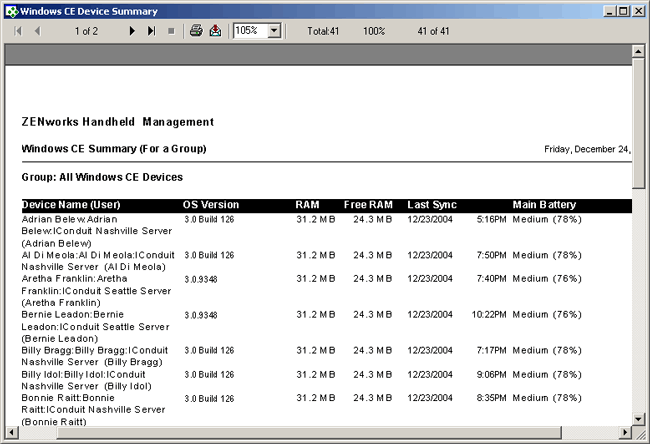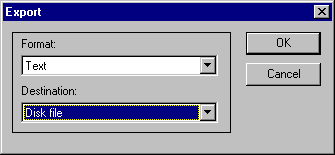5.4 Using Inventory Reports
You can generate reports about the hardware and software on your handheld devices to make it easy to see the applications you have installed, which devices need upgrades, which hardware components are installed, and more.
ZENworks Handheld Management provides predefined reports for information stored in the ZENworks Handheld Management database, including:
-
Handheld Application objects (status, run time, and so forth)
-
Devices (groups belonged to, distributions run, hardware/software inventory)
-
Groups
-
Software inventory (list of all software applications and where they are installed, unidentified files, and so forth)
-
Hardware inventory
After they are generated, reports can be viewed online, sent to a printer, or saved to a file in a variety of formats.
HINT:ZENworks Handheld Management is compatible with the Seagate* Software Crystal Reports* reporting engine. Using Crystal Reports, you can create your own custom reports. See your Crystal Reports documentation for further details.
The following sections contain more information about using reports:
5.4.1 Running Reports
You generate and view ZENworks Handheld Management reports in the ZENworks Handheld Management Inventory Viewer.
-
In ConsoleOne, right-click a handheld device object, click , then click .
-
Click , then select the type of report to generate.
After choosing a report, you might be prompted to pick a device or group before generating the data. After the report is generated, a screen similar to the following displays.

After the report is generated, you can scroll through the report, print it, or export it to many different formats including Excel, HTML, RTF, and so forth. The following illustration shows the toolbar buttons you can use to view and print the report.

5.4.2 Exporting Reports
After you generate a report you can export the report to a file or import the data into a database or spreadsheet.
Reports can be exported to formats such as HTML, tab/comma-delimited text files, Microsoft Excel, and so forth. After choosing the export format, you can choose the destination, such as a file, a Lotus Notes* database, or an e-mail system.
To export a report:
-
Click
 on the toolbar.
on the toolbar.

-
Choose the format in which to export the report.
-
Select the destination for the report.
-
Click .
You are prompted for additional information based on the format and destination.
5.4.3 Creating Custom Reports
Users who have Crystal Reports can create their own custom reports from the ZENworks Handheld Management server database.
The ZENworks Handheld Management server database can be either Microsoft Access* or MS SQL, depending on the database type you selected during the installation of the ZENworks Handheld Management server components. If you selected the option during the installation, the Handheld Management server database is the Microsoft Access database (serverdata.mdb) located in the Handheld Management server installation directory (by default, c:\progam files\novell\zfh). If you selected the option, the MS SQL Handheld Management server database is located in the path specified during the installation. For more information, see Installing the ZENworks Handheld Management Server
in the Novell ZENworks 7 Handheld Management Installation Guide.
IMPORTANT:If you create custom reports, the reports must be stored in a shared path if you want them to be accessed by a remote ConsoleOne installation. When saving a custom report, specify a UNC path to the share (do not use local drive letters).
To create a custom report:
-
In ConsoleOne, right-click a handheld device object, click , then click .
-
Click , then click .
-
Click .
The Add Custom Report dialog box is displayed.

-
Type a name for the report.
-
Specify a location for the report you created, then click .
-
Click to generate the report.
The report displays similar to any standard report.